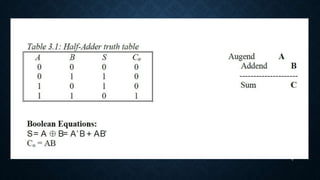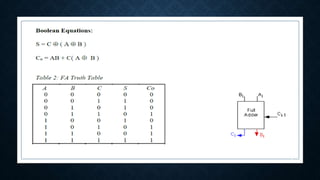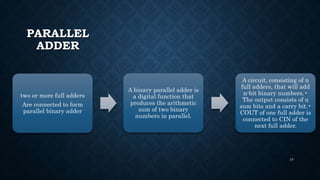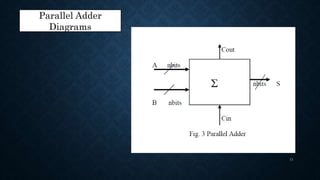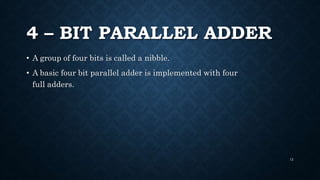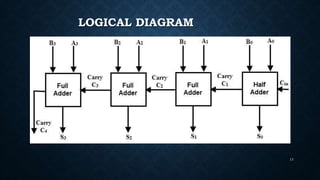Dld presentation
- 2. BINARY PARALLEL ADDER ? Binary Addition ? Half adder ? Full adder ? Parallel adder ? 4 ĻC bit parallel adder ? 8 ĻC bit parallel adder 2
- 3. 3
- 4. HALF ADDER ? A half adder is used to add two binary digits together, A and B. It produces S, the sum of A and B, and the corresponding carry out Co. ? Although by itself, a half adder is not extremely useful, it can be used as a building block for larger adding circuits (FA). ? One possible implementation is using two AND gates, two inverters, and an OR gate instead of a XOR gate . 4
- 5. 5
- 6. 6
- 7. FULL ADDER ? A full adder accepts two inputs and an output carry and generates a sum output and as an output carry. ? The basic difference between a half adder and a full adder is that the full adder accepts a input carry 7
- 8. 8
- 9. 9
- 10. PARALLEL ADDER two or more full adders Are connected to form parallel binary adder A binary parallel adder is a digital function that produces the arithmetic sum of two binary numbers in parallel. A circuit, consisting of n full adders, that will add n-bit binary numbers.? The output consists of n sum bits and a carry bit.? COUT of one full adder is connected to CIN of the next full adder. 10
- 12. 4 ĻC BIT PARALLEL ADDER ? A group of four bits is called a nibble. ? A basic four bit parallel adder is implemented with four full adders. 12
- 14. 14
- 15. TRUTH TABLE Cn-1 An Bn cn ĄÆn 0 0 0 0 0 0 0 1 0 1 0 1 0 0 1 0 1 1 1 0 1 0 0 0 1 1 0 1 1 0 1 1 0 1 0 1 1 1 1 1 15
- 16. 16
- 17. 17





